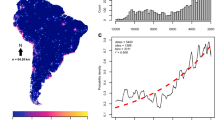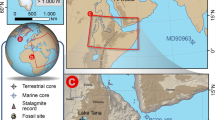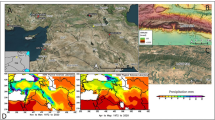Abstract
Understanding the resilience of early societies to climate change is an essential part of exploring the environmental sensitivity of human populations. There is significant interest in the role of abrupt climate events as a driver of early Holocene human activity, but there are very few well-dated records directly compared with local climate archives. Here, we present evidence from the internationally important Mesolithic site of Star Carr showing occupation during the early Holocene, which is directly compared with a high-resolution palaeoclimate record from neighbouring lake beds. We show that—once established—there was intensive human activity at the site for several hundred years when the community was subject to multiple, severe, abrupt climate events that impacted air temperatures, the landscape and the ecosystem of the region. However, these results show that occupation and activity at the site persisted regardless of the environmental stresses experienced by this society. The Star Carr population displayed a high level of resilience to climate change, suggesting that postglacial populations were not necessarily held hostage to the flickering switch of climate change. Instead, we show that local, intrinsic changes in the wetland environment were more significant in determining human activity than the large-scale abrupt early Holocene climate events.
This is a preview of subscription content, access via your institution
Access options
Access Nature and 54 other Nature Portfolio journals
Get Nature+, our best-value online-access subscription
$29.99 / 30 days
cancel any time
Subscribe to this journal
Receive 12 digital issues and online access to articles
$119.00 per year
only $9.92 per issue
Buy this article
- Purchase on Springer Link
- Instant access to full article PDF
Prices may be subject to local taxes which are calculated during checkout






Similar content being viewed by others
References
Flohr, P., Fleitmann, D., Matthews, R., Matthews, W. & Black, S. Evidence of resilience to past climate change in Southwest Asia: early farming communities and the 9.2 and 8.2 ka events. Quat. Sci. Rev. 136, 23–39 (2016).
De Pablo, J. F. L. & Jochim, M. A. The impact of the 8,200 cal bp climatic event on human mobility strategies during the Iberian late Mesolithic. J. Anthropol. Res. 66, 39–68 (2010).
Bicho, N., Umbelino, C., Detry, C. & Pereira, T. The emergence of Muge Mesolithic shell middens in central Portugal and the 8200 cal yr bp cold event. J. Isl. Coast. Archaeol. 5, 86–104 (2010).
Biehl, P. F. & Nieuwenhuyse, O. P. Climate and Cultural Change in Prehistoric Europe and the Near East (State Univ. New York Press, Albany, 2016).
Crombé, P. & Robinson, E. Human resilience to Lateglacial climate and environmental change in the Scheldt basin (NW Belgium). Quat. Int. 428, 50–63 (2017).
González-Sampériz, P. et al. Patterns of human occupation during the early Holocene in the central Ebro basin (NE Spain) in response to the 8.2 ka climatic event. Quat. Res. 71, 121–132 (2009).
Wicks, K. & Mithen, S. The impact of the abrupt 8.2 ka cold event on the Mesolithic population of western Scotland: a Bayesian chronological analysis using ‘activity events’ as a population proxy. J. Archeol. Sci. 45, 240–269 (2014).
Waddington, C. & Wicks, K. Resilience or wipe out? Evaluating the convergent impacts of the 8.2 ka event and Storegga tsunami on the Mesolithic of northeast Britain. J. Archeol. Sci. Rep. 14, 692–714 (2017).
Griffiths, S. & Robinson, E. The 8.2 ka bp Holocene climate change event and human population resilience in northwest Atlantic Europe. Quat. Int. 465, 251–257 (2018).
Woodman, P. C. in Chronology and Evolution Within the Mesolithic of North-West Europe (eds Crombé, P., Van Strydonck, M., Boudin, M. & Bats, M.) 195–215 (Cambridge Scholars, Newcastle upon Tyne, 2009).
Mayewski, P. et al. Holocene climate variability. Quat. Res. 62, 243–255 (2004).
Daley, T. J. et al. The 8200 yr bp cold event in stable isotope records from the North Atlantic region. Glob. Planet Change 79, 288–302 (2011).
Contreras, D. A. & Meadows, J. Summed radiocarbon calibrations as a population proxy: a critical evaluation using a realistic simulation approach. J. Archeol. Sci. 52, 591–608 (2014).
Edwards, K. J., Langdon, P. G. & Sugden, H. Separating climatic and possible human impacts in the early Holocene: biotic response around the time of the 8200 cal. yr bp event. J. Quat. Sci. 22, 77–84 (2007).
Rasmussen, S. O. et al. A stratigraphic framework for abrupt climatic changes during the Last Glacial period based on three synchronized Greenland ice-core records: refining and extending the INTIMATE event stratigraphy. Quat. Sci. Rev. 106, 14–28 (2014).
Clark, J. G. D. Excavations at Star Carr: An Early Mesolithic Site at Seamer Near Scarborough, Yorkshire (Cambridge Univ. Press, Cambridge, 1954).
Mellars, P. & Dark, P. Star Carr in Context: New Archaeological and Palaeoecological Investigations at the Early Mesolithic Site of Star Carr, North Yorkshire (McDonald Institute for Archaeological Research, Cambridge, 1998).
Conneller, C., Milner, N., Taylor, B. & Taylor, M. Substantial settlement in the European early Mesolithic: new research at Star Carr. Antiquity 86, 1004–1020 (2012).
Conneller, C., Bayliss, A., Milner, N. & Taylor, B. The resettlement of the British landscape: towards a chronology of early Mesolithic lithic assemblage types. Internet Arch. 42, https://doi.org/10.11141/ia.42.12 (2016).
Milner, N., Taylor, B., Conneller, C. & Schadla-Hall, R. T. S tar Carr: Life in Britain After the Ice Age (Council for British Archaeology, 2013).
Palmer, A. P. et al. The evolution of Palaeolake Flixton and the environmental context of Star Carr, NE. Yorkshire: stratigraphy and sedimentology of the Last Glacial–Interglacial Transition (LGIT) lacustrine sequences. Proc. Geol. Assoc. 126, 50–59 (2015).
Conneller, C. & Schadla-Hall, R. T. Beyond Star Carr: the Vale of Pickering in the tenth millennium bp. Proc. Prehis. Soc. 69, 85–105 (2003).
Little, A. et al. Technological analysis of the world’s earliest shamanic costume: a multi-scalar, experimental study of a red deer headdress from the early Holocene site of Star Carr, North Yorkshire, UK. PLoS ONE 11, e0152136 (2016).
Marshall, J. D. et al. Terrestrial impact of abrupt changes in the North Atlantic thermohaline circulation: early Holocene, UK. Geology 35, 639–642 (2007).
Tye, G. J. et al. The δ18O stratigraphy of the Hoxnian lacustrine sequence at Marks Tey, Essex, UK: implications for the climatic structure of MIS 11 in Britain. J. Quat. Sci. 31, 75–92 (2016).
Rasmussen, S. O., Vinther, B. M., Clausen, H. B. & Andersen, K. K. Early Holocene climate oscillations recorded in three Greenland ice cores. Quat. Sci. Rev. 26, 1907–1914 (2007).
Kobashi, T., Severinghaus, J. P., Brook, E. J., Barnola, J.-M. & Grachev, A. M. Precise timing and characterization of abrupt climate change 8200 years ago from air trapped in polar ice. Quat. Sci. Rev. 26, 1212–1222 (2007).
Candy, I. et al. Oxygen isotopic evidence for high-magnitude, abrupt climatic events during the Lateglacial Interstadial in northwest Europe: analysis of a lacustrine sequence from the site of Tirinie, Scottish Highlands. J. Quat. Sci. 31, 607–621 (2016).
Candy, I., Stephens, M., Hancock, J. D. R. & Waghorn, R. S. in The Ancient Human Occupation of Britain (Developments in Quaternary Science) (eds Ashton, N., Lewis, S. G. & Stringer, C.) 23–37 (Elsevier, Amsterdam, 2011).
Jessen, C. A. et al. Early Maglemosian culture in the Preboreal landscape: archaeology and vegetation from the earliest Mesolithic site in Denmark at Lundby Mose, Sjælland. Quat. Int. 378, 73–87 (2015).
Holmes, J. A. et al. Lake isotope records of the 8200-year cooling event in western Ireland: comparison with model simulations. Quat. Sci. Rev. 131, 341–349 (2016).
Troels-Smith, J. Characterisation of Unconsolidated Sediments (Reitzels Forlag, Copenhagen, 1955).
Juggins, S. C2 Version 1.7.7 (Newcastle Univ., 2016); https://www.staff.ncl.ac.uk/stephen.juggins/software/C2Home.htm
Moore, P. D., Webb, J. A. & Collinson, M. E. Pollen Analysis (Blackwell Scientific, London, 1991).
Grimm, E. C. CONISS: a FORTRAN 77 program for stratigraphically constrained cluster analysis by the method of incremental sum of squares. Comp. Geosci. 13, 13–35 (1987).
Brooks, S. J., Langdon, P. G. & Heiri, O. The Identification and Use of Palaearctic Chironomidae Larvae in Palaeoecology (Quaternary Research Association, London, 2007).
Brooks, S. J. & Birks, H. J. B. Chironomid-inferred air temperatures from Late-Glacial and Holocene sites in north-west Europe: progress and problems. Quat. Sci. Rev. 20, 1723–1741 (2001).
Darling, W. G. Hydrological factors in the interpretation of stable isotopic proxy data present and past: a European perspective. Quat. Sci. Rev. 23, 743–770 (2004).
Dickson C. A. in Studies in the Vegetation History of the British Isles (eds Walker, D. & West, R. G.) 233–254 (Cambridge Univ. Press, Cambridge, 1970).
Bronk Ramsey, C., Higham, T. F. G. & Leach, P. Towards high precision AMS: progress and limitations. Radiocarbon 46, 17–24 (2004).
Bronk Ramsey, C. Deposition models for chronological. Quat. Sci. Rev. 27, 42–60 (2008).
Bronk Ramsey, C. Dealing with outliers and offsets in radiocarbon dating. Radiocarbon 51, 1023–1045 (2009).
Bronk Ramsey, C. Bayesian analysis of radiocarbon dates. Radiocarbon 51, 337–360 (2009).
Reimer, P. J. et al. IntCal13 and Marine13 radiocarbon age calibration curves 0–50,000 years cal bp. Radiocarbon 55, 1869–1887 (2013).
Bronk Ramsey, C. et al. Improved age estimates for key Late Quaternary European tephra horizons in the RESET lattice. Quat. Sci. Rev. 118, 18–32 (2015).
Milner, N., Conneller, C. & Taylor, B. Star Carr, Volume 2: Studies in Technology, Subsistence and Environment (White Rose Univ. Press, York, in the press).
Dark, P. in Star Carr in Context: New Archaeological and Palaeoecological Investigations at the Early Mesolithic Site of Star Carr, North Yorkshire (eds Mellars, P. & Dark, P.) 11–120 (McDonald Institute for Archaeological Research, Cambridge, 1998).
Bronk Ramsey, C. OxCal Version 4.3 (2017); https://c14.arch.ox.ac.uk/oxcal/OxCal.html
Bedford, A., Jones, R. T., Lang, B., Brooks, S. & Marshall, J. D. A Late-Glacial chironomid record from Hawes Water, northwest England. J. Quat. Sci. 19, 281–290 (2004).
Acknowledgements
We thank the landowners of Star Carr, English Heritage/Historic England, and Natural England for granting permission to excavate. N.M. received funding for this from the European Research Council under the European Union’s Seventh Framework Programme (FP7/2007-2013) under grant agreement 283938, British Academy grants SG-44333, SG-47081 and SG-50217, English Heritage/Historic England grants 5536, 6064, 6793 and 6796, and Historic England also contributed directly towards the costs of the radiocarbon dating of the site, Natural Environment Research Council grant NE/I015191/1, and the Vale of Pickering Research Trust. R.S. is supported by an Early Career Fellowship from the Leverhulme Trust (ECF-2015-396). A.A. is supported by the Natural Environment Research Council's London Doctoral Training Partnership.
Author information
Authors and Affiliations
Contributions
S.B., I.C., I.M., P.Lan. and A.P. designed and directed the climate and environmental analysis. S.B. and A.M. analysed the tephra. I.C. directed the carbon and oxygen isotope analyses, which were conducted by L.D., C.D. and R.K. I.M. and A.A. analysed the pollen data. A.P., S.B., I.M., A.A., A.M., I.C. and P.Lin. analysed the lake topography and sediments. B.T. analysed macrofossil data from the site. M.B. and M.T. analysed the archaeological wood and platforms. P.Lan and C.L. analysed the chironomid samples. R.S. carried out the radiocarbon dating. A.B. carried out the Bayesian modelling with assistance from I.M., S.B., A.P., A.A., C.C., B.T., P.Lin. and N.M. N.B. carried out the source proportion mixing modelling. N.M., B.T. and C.C. designed and directed the archaeological excavation. S.B., I.C., A.B., P. Lan. and N.M. led the writing of the paper. All authors contributed to writing the paper, discussed the results and commented on the manuscript.
Corresponding author
Ethics declarations
Competing interests
The authors declare no competing interests.
Additional information
Publisher’s note: Springer Nature remains neutral with regard to jurisdictional claims in published maps and institutional affiliations.
Supplementary information
Supplementary Information
Supplementary text, figures, tables and references.
Supplementary Data
Priors, javascript, OxCal and text files forming the basis for the site chronology and integrated lake record
Rights and permissions
About this article
Cite this article
Blockley, S., Candy, I., Matthews, I. et al. The resilience of postglacial hunter-gatherers to abrupt climate change. Nat Ecol Evol 2, 810–818 (2018). https://doi.org/10.1038/s41559-018-0508-4
Received:
Accepted:
Published:
Issue Date:
DOI: https://doi.org/10.1038/s41559-018-0508-4
This article is cited by
-
Unraveling Early Holocene occupation patterns at El Arenal de la Virgen (Alicante, Spain) open-air site: an integrated palimpsest analysis
Archaeological and Anthropological Sciences (2023)
-
Early Holocene wetland succession at Lake Flixton (UK) and its implications for Mesolithic settlement
Vegetation History and Archaeobotany (2019)



